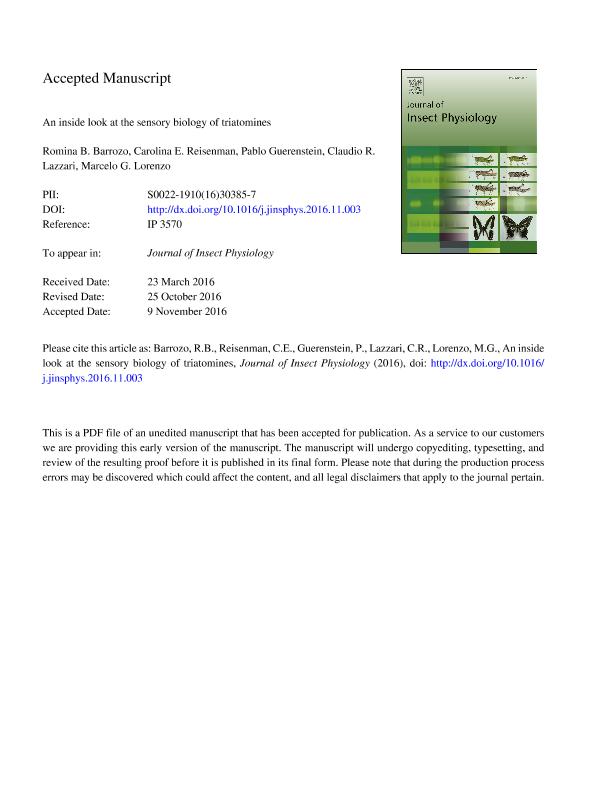Artículo
An inside look at the sensory biology of triatomines
Barrozo, Romina ; Reisenman, Carolina Esther; Guerenstein, Pablo Gustavo
; Reisenman, Carolina Esther; Guerenstein, Pablo Gustavo ; Lazzari, Claudio Ricardo
; Lazzari, Claudio Ricardo ; Lorenzo, Marcelo Gustavo
; Lorenzo, Marcelo Gustavo
 ; Reisenman, Carolina Esther; Guerenstein, Pablo Gustavo
; Reisenman, Carolina Esther; Guerenstein, Pablo Gustavo ; Lazzari, Claudio Ricardo
; Lazzari, Claudio Ricardo ; Lorenzo, Marcelo Gustavo
; Lorenzo, Marcelo Gustavo
Fecha de publicación:
02/2017
Editorial:
Pergamon-Elsevier Science Ltd
Revista:
Journal of Insect Physiology
ISSN:
0022-1910
Idioma:
Inglés
Tipo de recurso:
Artículo publicado
Clasificación temática:
Resumen
Although kissing bugs (Triatominae: Reduviidae) are perhaps best known as vectors of Chagas disease, they are important experimental models in studies of insect sensory physiology, pioneered by the seminal studies of Wigglesworth and Gillet more than eighty years ago. Since then, many investigations have revealed that the thermal, hygric, visual and olfactory senses play critical roles in the orientation of these blood-sucking insects towards hosts. Here we review the current knowledge about the role of these sensory systems, focussing on relevant stimuli, sensory structures, receptor physiology and the molecular players involved in the complex and cryptic behavioural repertoire of these nocturnal insects. Odours are particularly relevant, as they are involved in host search and are used for sexual, aggregation and alarm communication. Tastants are critical for a proper recognition of hosts, food and conspecifics. Heat and relative humidity mediate orientation towards hosts and are also important for the selection of resting places. Vision, which mediates negative phototaxis and flight dispersion, is also critical for modulating shelter use and mediating escape responses. The molecular bases underlying the detection of sensory stimuli started to be uncovered by means of functional genetics due to both the recent publication of the genome sequence of Rhodnius prolixus and the availability of modern genome editing techniques.
Palabras clave:
Kissing Bugs
,
Mechanoreception
,
Olfaction
,
Taste
,
Thermal Sense
,
Triatominae
,
Vision
Archivos asociados
Licencia
Identificadores
Colecciones
Articulos(CICYTTP)
Articulos de CENTRO DE INV.CIENT.Y TRANSFERENCIA TEC A LA PROD
Articulos de CENTRO DE INV.CIENT.Y TRANSFERENCIA TEC A LA PROD
Articulos(IBBEA)
Articulos de INSTITUTO DE BIODIVERSIDAD Y BIOLOGIA EXPERIMENTAL Y APLICADA
Articulos de INSTITUTO DE BIODIVERSIDAD Y BIOLOGIA EXPERIMENTAL Y APLICADA
Citación
Barrozo, Romina; Reisenman, Carolina Esther; Guerenstein, Pablo Gustavo; Lazzari, Claudio Ricardo; Lorenzo, Marcelo Gustavo; An inside look at the sensory biology of triatomines; Pergamon-Elsevier Science Ltd; Journal of Insect Physiology; 97; 2-2017; 3-19
Compartir
Altmétricas



